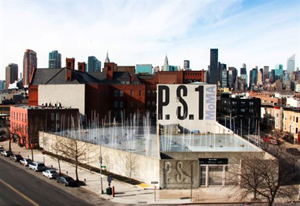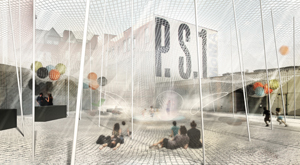In 2009, just two months after the Dutch- and Chinese-born architects Florian Idenburg and Jing Liu established their office Solid Objectives – Idenburg Liu (SO–IL) in Brooklyn, the pair was recommended to compete in the MoMA/P.S.1 Young Architects Program, which gives emerging designers the opportunity to design the courtyard entrance of the P.S.1 Contemporary Art Center. “We submitted our very thin portfolio then, but we were not selected as one of the five finalists,” Idenburg recalls.



They tried again this year, and not only made the first cut — they won. Their scheme, called Pole Dance, will launch in June, serving as an interactive environment for the museum’s 2010 Warm Up music series. It will remain open through the summer.
This is the eleventh courtyard commission of the Young Architects Program. To mark the new decade, contest sponsors Museum of Modern Art and P.S.1 are spotlighting projects that emphasize aspects of sustainability. SO–IL’s winning proposal can be reused: The $85,000 intervention will fill the P.S.1 courtyard with 25-foot fiberglass poles arranged in 12-by-12-foot grids, connected by bungee cords and shrouded in nylon netting. The poles are mounted via rubber-joint connection to a steel base, and all parts are off-the-shelf and mechanically connected for easy redeployment or recycling.
Overall Pole Dance represents, in Idenburg’s words, “Architecture which is not this or that, black or white, but a field of interrelated, constantly shifting, and morphing elements that together create a complex order.” Thanks to the structural composition of poles and bungees, the 2-inch-diameter poles will sway according to touch or uses like lounging in the hammocks tied to the framework. While the nylon mesh is intended to stabilize the poles’ movement, water-filled balance balls placed on top of the netting will bounce around in response to the bobbing and shaking. (The mesh will also descend to the courtyard datum at two points, encompassing a pool and sandpit.)
In 2009 SO–IL completed its first commission in New York, the 11,000-square-foot conversion of a former kickboxing gym into offices for the fashion house Derek Lam (SANAA designed the retail space). The firm, with Diller-Scofidio+Renfro, also has been selected as one of 20 teams to design new facilities for the Netherlands Dance Theatre.
Despite the far fatter portfolio, “We hope it will provide a career boost, especially in these tough times,” Idenburg says of Pole Dance. “And it is an excellent project for us to test new ideas, and to establish a voice that’s ours.” Indeed, currently SO–IL is applying similar themes of “ambivalent architecture” to a 45,000-square-foot private museum near The Hague and to a project space for Kukje Gallery in Seoul.
This year SO–IL beat out the Copenhagen design studio BIG–Bjarke Ingels Group and Cambridge, Massachusetts–based William O’Brien Jr. for the P.S.1 display, as well as fellow Brooklyn-based finalists Easton+Combs and Freecell.



Post a comment to this article
Report Abusive Comment